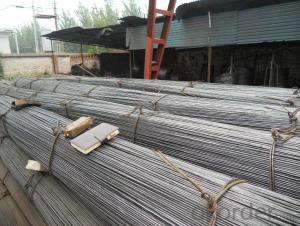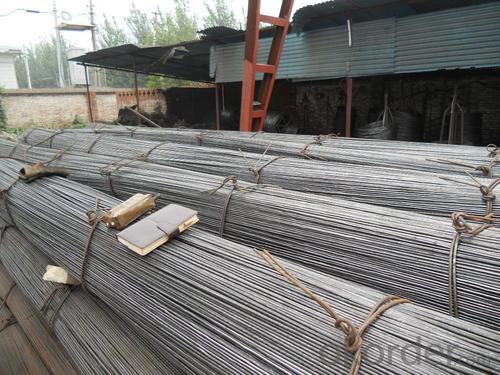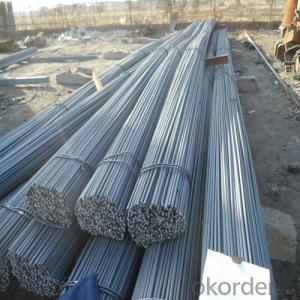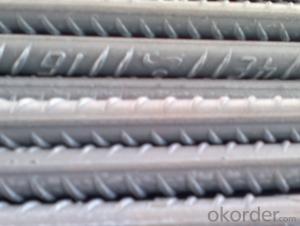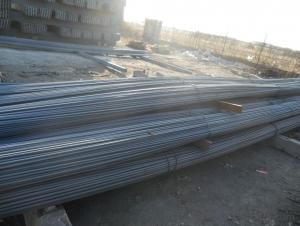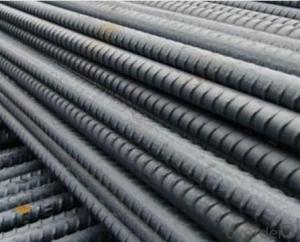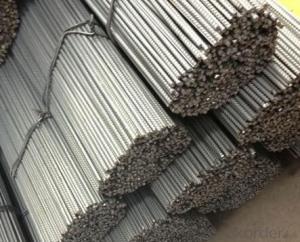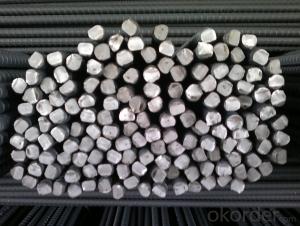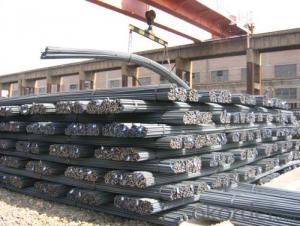HR Deformed Steel Rebars of Good Quality
- Loading Port:
- Tianjin
- Payment Terms:
- TT OR LC
- Min Order Qty:
- 25 m.t.
- Supply Capability:
- 200000 m.t./month
OKorder Service Pledge
OKorder Financial Service
You Might Also Like
Specifications of HR Deformed Steel Rebars of Good Quality:
Standard | GB UK USA | HRB335 HRB400 HRB500 G460B, B500A, B500B,B500C GR40, GR60 | |
Diameter | 6mm,8mm,10mm,12mm,14mm,16mm,18mm,20mm, 22mm,25mm,28mm,32mm,36mm,40mm,50mm | ||
Length | 6M, 9M,12M or as required | ||
Price | Keep lower operating costs so as to offer competitive price for our clients | ||
Label | to be specified by customer, generally, each bundle has 1-2 labels | ||
Application | Building, construction | ||
Invoicing | Actual or Theoretical Weight Basis as buyer’s request. | ||
Type | Hot rolled steel rebar | ||
Brand name | DRAGON | ||
Theoretical weight and section area of each diameter as below for your information:
Diameter(mm) | Section area (mm²) | Mass(kg/m) | Weight of 12m (kg) | Pcs/ton |
6 | 28.27 | 0.222 | 2.664 | 375.38 |
8 | 50.27 | 0.395 | 4.74 | 210.97 |
10 | 78.54 | 0.617 | 7.404 | 135.06 |
12 | 113.1 | 0.888 | 10.656 | 93.84 |
14 | 153.9 | 1.21 | 14.52 | 68.87 |
16 | 201.1 | 1.58 | 18.96 | 52.74 |
18 | 254.5 | 2.00 | 24 | 41.67 |
20 | 314.2 | 2.47 | 29.64 | 33.74 |
22 | 380.1 | 2.98 | 35.76 | 27.96 |
25 | 490.9 | 3.85 | 46.2 | 21.65 |
28 | 615.8 | 4.83 | 57.96 | 17.25 |
32 | 804.2 | 6.31 | 75.72 | 13.21 |
36 | 1018 | 7.99 | 98.88 | 10.43 |
40 | 1257 | 9.87 | 118.44 | 8.44 |
50 | 1964 | 15.42 | 185.04 | 5.40 |
Steel Rebar in warehouse

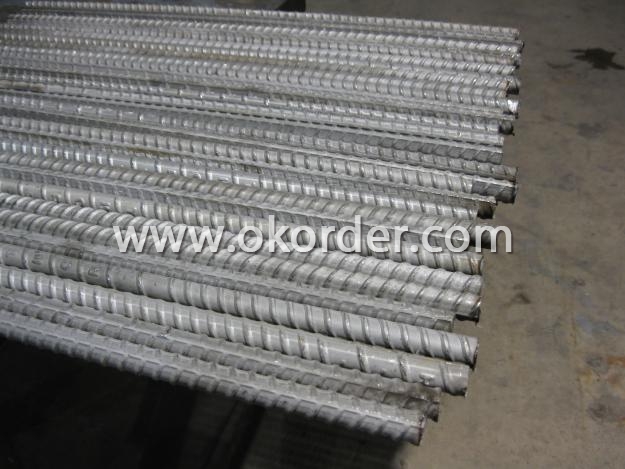
Chemical Composition: (Please kindly find our chemistry of our material based on BS4449 as below for your information)
BS4449 G460B | Chemical Composition | ||||
C | Mn | Si | S | P | |
0.18 | 0.35 | 0.14 | 0.025 | 0.25 | |
Physical capability | |||||
Yield Strength(N/cm²) | Tensile Strength(N/cm²) | Elongation (%) | |||
625 | ≥460 | 18 | |||
Usage and Applications of HR Deformed Steel Rebars of Good Quality:
Deformed bar is widely used in buildings, bridges, roads and other engineering construction. Big to highways, railways, bridges, culverts, tunnels, public facilities such as flood control, dam, small to housing construction, beam, column, wall and the foundation of the plate, deformed bar is an integral structure material. With the development of world economy and the vigorous development of infrastructure construction, real estate, the demand for deformed bar will be larger and larger..
Packaging & Delivery of HR Deformed Steel Rebars of Good Quality:
Packaging Detail: products are packed in bundle and then shipped by container or bulk vessel, deformed bar is usually naked strapping delivery, when storing, please pay attention to moisture proof. The performance of rust will produce adverse effect.
Each bundle weight: 2-3MT, or as required
Payment terms: TT payment in advance or Irrevocable LC at sight.
Trade terms :FOB, CFR, CIF
Delivery Detail: within 45 days after received advanced payment or LC.
Note:
1. Our products are produced according to national standard (GB), if not, supply according to national standards (GB) or agreement as customer required.
2. Other Grade and Standard Deformed Steel Bar we can supply:
Grade: GR40/GR60, G460B/B500A/B500B/B500C,BST500S
Standard: ASTM, BS, DIN
The Minimum Order Quantity of these products is high, and need to be confirmed.
3. We can not only supply Deformed Steel Bar; if you need anything about building materials, please contact us for further information.
4. Please send us your detail specifications when inquire. We will reply to you as soon as possible. We sincerely hope we can establish a long stable business relationship.
- Q: Can steel rebars be used in the construction of railway or subway systems?
- Yes, steel rebars can be used in the construction of railway or subway systems. Steel rebars, also known as reinforcement bars, are commonly used in construction projects to provide strength and durability to concrete structures. In the case of railway or subway systems, steel rebars are often used to reinforce the concrete foundations, pillars, beams, and other structural components of the infrastructure. The use of steel rebars helps to enhance the structural integrity and load-bearing capacity of the railway or subway system, ensuring its safety and longevity. Additionally, steel rebars are also corrosion-resistant, which is crucial in environments where there may be exposure to moisture or chemicals. Therefore, steel rebars are a reliable and commonly used material in the construction of railway or subway systems.
- Q: Can steel rebars be used in the construction of offshore oil platforms?
- Indeed, the inclusion of steel rebars is deemed feasible for the construction of offshore oil platforms. In construction practices, steel rebars are commonly employed to fortify concrete structures, thereby enhancing their strength and durability. In the context of offshore oil platforms, the use of steel rebars serves to fortify the concrete foundations and structures of the platform, facilitating its resistance against the adverse environmental conditions as well as the weight of the equipment and infrastructure situated on the platform. These steel rebars are engineered to withstand corrosion and are typically coated with epoxy or other protective coatings to prevent rusting within the corrosive marine environment. Additionally, steel rebars can be specifically tailored to meet the precise requirements of the offshore oil platform, thereby ensuring that they deliver the essential strength and stability.
- Q: What is the typical lead time for ordering steel rebars?
- The typical lead time for ordering steel rebars can vary depending on factors such as the quantity required, supplier availability, and current market conditions. However, it is common for lead times to range from a few days to several weeks, with larger orders often requiring more time for production and delivery. It is always advisable to consult with the specific supplier or manufacturer to get an accurate estimate of the lead time for ordering steel rebars.
- Q: 12 of the threaded steel can replace 16 of the screw steel? But the same proportion. Thanks
- 12 of the screw steel, rice weight is 0.89kg/m, 16 of the screw steel, rice weight is 1.57kg/m, with 12 of the thread steel instead of 16 of the screw steel, to the same proportion, that in dosage will be more.
- Q: What are the common defects or issues associated with steel rebars?
- Common defects or issues associated with steel rebars include: 1. Rust: Steel rebars are prone to rusting when exposed to moisture or corrosive substances. Rust weakens the rebars, reducing their load-bearing capacity and compromising the structural integrity of the reinforced concrete. 2. Poor bonding with concrete: If the rebars are not properly cleaned or have a layer of rust, they may not bond well with the concrete. This can result in reduced strength and durability of the reinforced concrete structure. 3. Improper size or shape: Rebars that are incorrectly sized or shaped can lead to structural issues. For example, rebars that are too short or have inadequate coverage may not provide sufficient reinforcement, making the structure vulnerable to cracking or collapse. 4. Improper placement: Incorrect placement of rebars can lead to weak points in the reinforced concrete. This can occur if rebars are not adequately spaced, not aligned properly, or if there are gaps between the rebar and the concrete. 5. Improper storage and handling: Rebars should be stored in a dry and well-ventilated area to prevent rust. Improper storage or handling can result in surface damage, bending, or twisting of the rebars, affecting their performance in the reinforced concrete. 6. Welding defects: Welded rebars may have defects such as improper fusion, cracks, or lack of penetration, which can compromise the strength and integrity of the reinforcement. 7. Overlapping issues: Overlapping rebars is a common practice to ensure continuity in reinforcement. However, improper overlapping, such as insufficient overlap length or inadequate lapping of rebars, can result in weak joints and reduced structural strength. 8. Quality control issues: Inadequate quality control during the manufacturing or installation process can lead to defects or issues in rebars. This can include issues like improper chemical composition, inadequate strength, or deviations from the specified standards. It is crucial to address and rectify these defects or issues during the design, manufacturing, and construction stages to ensure the safe and reliable performance of reinforced concrete structures. Regular inspection, maintenance, and adherence to industry standards and guidelines are essential to mitigate these common issues associated with steel rebars.
- Q: Is the finish steel 3 grade steel?
- The mechanical properties of finishing rolling rebar with GB/T "20065-2006" thread steel bar for prestressed concrete, the prestressed concrete rebar (also known as the finishing rolling rebar, hereinafter referred to as reinforced) the terms and definitions, strength grade, size, shape, weight and tolerances, technical requirements, test method, inspection rules, packaging, mark and quality certificate. The standard applies to the use of hot rolling, after rolling waste heat treatment or heat treatment processes such as the production of prestressed concrete rebar.
- Q: How do steel rebars affect the overall safety of construction projects?
- Steel rebars play a crucial role in enhancing the overall safety of construction projects. Firstly, steel rebars provide reinforcement to concrete structures, making them stronger and more resistant to various types of forces such as tension, compression, and bending. This reinforcement significantly increases the structural integrity of buildings, bridges, and other constructions, reducing the risk of collapse or failure. Moreover, steel rebars have excellent ductility, meaning they can deform without fracturing under extreme loads. This property allows rebars to absorb and distribute the energy generated during earthquakes, high winds, or heavy impacts, preventing sudden and catastrophic structural failures. Additionally, steel rebars can withstand high temperatures and fire, maintaining their strength and integrity even in the event of a fire, which is crucial for ensuring the safety of occupants. Furthermore, steel rebars are resistant to corrosion, which is a common issue in construction projects. Corrosion weakens the structure by gradually deteriorating the reinforcement. By using steel rebars, the risk of corrosion is significantly reduced, lengthening the lifespan of the construction and ensuring its long-term safety. Overall, the use of steel rebars in construction projects is vital for guaranteeing the safety and durability of structures. They enhance the strength, stability, and resistance of the building, making it capable of withstanding various external forces and potential hazards. By incorporating steel rebars into construction designs, engineers and builders can ensure that the finished project meets the required safety standards, providing peace of mind for both the construction industry professionals and the public.
- Q: Can steel rebars be used in dam construction projects?
- Certainly, steel rebars can be utilized in dam construction projects without a doubt. In the construction industry, steel rebars are commonly employed for reinforcing concrete structures, and dams are no exception to this rule. To enhance the tensile strength of concrete, the rebars are embedded within it, thereby rendering it more resistant to cracking and structural failure. Dams, being colossal structures engineered to withhold water, necessitate a high level of strength and durability to withstand the tremendous forces and pressures exerted by the water. By providing the required reinforcement, steel rebars ensure the dam's structural integrity. Moreover, steel rebars possess corrosion-resistant properties, which are of utmost significance in dam construction, where constant exposure to water occurs. All in all, the utilization of steel rebars in dam construction projects is a well-established and vital practice.
- Q: What are the guidelines for protecting steel rebars during concrete placement and compaction?
- The guidelines for protecting steel rebars during concrete placement and compaction include ensuring that the rebars are clean and free from any rust, grease, or other contaminants. They should be properly tied and supported to maintain their position and prevent displacement during the concrete pouring process. Additionally, rebars should be adequately spaced to allow concrete to flow around them and provide sufficient cover, as specified in the design requirements. Care should be taken to avoid damaging the rebars during compaction, and vibrating equipment should be used cautiously to prevent excessive force or vibration that could cause rebars to shift or become dislodged. Regular inspections should be conducted to check for any damage or movement of the rebars, and necessary repairs or reinforcement should be done promptly to ensure the structural integrity of the concrete.
- Q: Can steel rebars be used in high-rise building construction?
- Yes, steel rebars can be used in high-rise building construction. Steel rebars are widely used in the construction industry due to their strength and durability. In high-rise buildings, where the structural integrity is crucial, steel rebars are commonly used to reinforce concrete and provide extra strength to withstand the vertical and lateral forces.
Send your message to us
HR Deformed Steel Rebars of Good Quality
- Loading Port:
- Tianjin
- Payment Terms:
- TT OR LC
- Min Order Qty:
- 25 m.t.
- Supply Capability:
- 200000 m.t./month
OKorder Service Pledge
OKorder Financial Service
Similar products
Hot products
Hot Searches
Related keywords
